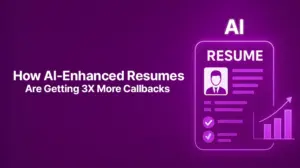You’re showing up to work, you’re attending meetings, you’re replying to emails, but deep down, there is something that is missing.
Welcome to the world of quiet quitting — where employees silently disengage, not because they don’t care, but because they’ve stopped believing their effort makes a difference. If you are feeling disengaged at work, you are not alone. According to recent Gallup’s research, 77% of the global workforce don’t feel engaged at what they are doing at work.
And now, even AI knows it. With advanced productivity monitoring tools, companies aren’t just watching how much you work — they’re analyzing how engaged you are.
In this blog, we’ll unpack why quiet quitting happens, how AI is changing the way companies detect it, and what you can do if your current job no longer feels right.
What Is Quiet Quitting — and Why Are So Many Doing It?

Quiet quitting is a behavioral pattern where employees emotionally disengage from their work, doing only the bare minimum required for their role. They fulfill core responsibilities to keep their job but intentionally avoid going beyond — such as taking on extra tasks, staying late, or contributing outside their job scope.

Get noticed by recruiters and hired by top global companies faster.
Here’s why you might be doing quiet quitting without even realizing it:
Burnout & Lack of Boundaries
In many workplaces, especially post-pandemic, the pressure to be constantly available has skyrocketed. Employees are expected to respond to emails late at night, attend back-to-back virtual meetings, and juggle multiple roles — often without clear boundaries. For instance, you finish your workday, but Slack messages keep coming in. You’re expected to “just quickly” join a call at 8 PM. Over time, your evenings blur into your work hours, and your weekends become recovery zones. This leads to burnout, which isn’t just feeling tired — it’s a state of emotional, physical, and mental exhaustion caused by prolonged stress.
Feeling Underappreciated
Recognition is one of the most powerful motivators — and one of the most overlooked. When you are consistently delivering results but receive no acknowledgment, you may begin to feel invisible. Over time you might have realized that appreciation isn’t just about bonuses or awards; it’s about being seen, heard, and valued. For instance, you stayed late to finish a project, solved a major issue, or helped a teammate — but no one noticed. No thank-you, no feedback, no mention in the team meeting. Eventually, you stop trying to go the extra mile because it feels like no one is watching it anyway.
Toxic or Micromanaging Leadership
Leadership can either inspire or suffocate. Toxic managers who belittle, control, or ignore their teams create environments of fear and frustration. Micromanagement, in particular, signals a lack of trust — and trust is the foundation of engagement. For example, your manager questions every decision you make, overrides your ideas, and constantly checks in on your work. You feel like a cog in a machine, not a contributor. You stop sharing ideas, stop taking initiative, and start doing just enough to avoid conflict. Quiet quitting is often a defense mechanism in toxic environments.
Repetitive or Meaningless Work
Humans crave purpose. If you find your purpose in work, and work itself feels monotonous, disconnected from impact, or devoid of creativity, it becomes hard to stay engaged. Employees want to know that what they do matters — not just to the company, but to themselves. For instance, you spend your days filling out spreadsheets, attending meetings that go nowhere, and executing tasks that feel like busywork. There’s no innovation, no challenge, no sense of contribution. Quiet quitting is a reaction to purposelessness.
Caught by AI: How Companies React — And What It Reveals
As AI-powered tools become more embedded in workplace systems, companies are increasingly using them to monitor employee behavior — tracking productivity metrics, analyzing communication patterns, and even interpreting emotional tone in emails and meetings.

When these systems flag someone as “disengaged,” the reaction from management can vary — but it often reveals more about the company’s culture than the employee’s performance.
Increased Micromanagement
One of the most common reactions is to tighten control. Managers, alerted by AI dashboards, may begin to scrutinize the flagged employee more closely:
- Frequent check-ins
- More detailed task tracking
- Pressure to “prove” productivity
But here’s the irony: micromanagement is often one of the root causes of disengagement. So when it’s used as a response, it doesn’t solve the problem — it deepens it.
Conversations with HR or Managers
In some cases, being flagged leads to a formal conversation — a meeting with HR or a manager to “discuss performance.” While this can be an opportunity for support, it often lacks empathy or context.
Employees may be asked:
- Why aren’t you contributing more?
- Is something wrong?
- Are you still committed to your role?
But these conversations often miss the mark. They focus on output, not experience. They ask what is happening, but not why.
Total Misunderstanding of the Root Cause
Perhaps the most damaging outcome is when companies misinterpret the data entirely. AI might detect fewer emails sent, shorter meeting responses, or reduced collaboration — and label it as disengagement.
But what if:
- The employee is dealing with personal challenges?
- They’re burned out from unrealistic expectations?
- They’ve lost trust in leadership?
Without context, AI can’t distinguish between strategic withdrawal and emotional collapse. And when companies act on incomplete data, they risk alienating the very people they’re trying to retain. The real issue isn’t the employee being caught — it’s the environment that made disengagement feel like the only option.
The Bigger Picture: AI as a Mirror, Not a Judge
AI can be a powerful tool — but only if it’s used to understand, not just to monitor. When companies treat AI alerts as a starting point for empathy, reflection, and change, they can uncover deeper organizational issues:
- Broken communication channels
- Leadership gaps
- Cultural misalignment
- Lack of psychological safety
But when AI is used to enforce compliance, it becomes a surveillance tool — and employees retreat even further.

Build AI-powered resumes, prepare with on-demand interview tools, analyze skill gaps, and more — all under one roof.
How to Reclaim Your Career Before It’s Flagged by AI
If you’ve been quietly quitting — or just quietly surviving — here’s the truth: you’re not broken, and you’re not alone. But staying stuck isn’t the only option. Whether you’ve been flagged by an AI productivity tracker or just feel the disengagement creeping in, now’s the time to take back control of your career — before someone (or something) else makes that call for you.

Start with an honest conversation
Before you check out entirely, try checking in — with your manager. A candid, respectful conversation can go a long way. Share what’s not working, what’s draining you, and what kind of support you need. Often, leaders don’t realize you’re struggling until it’s too late. You don’t need to vent — just be real. Ask for flexibility, resources, or opportunities that align with your goals.
Set better boundaries
Burnout doesn’t need a grand event — it builds silently, task by task, message by message. Reclaim your time. Log off when your workday ends. Block focus hours on your calendar. Stop normalizing late-night pings. You teach people how to treat your time by the boundaries you uphold. Protect your energy — it’s your most valuable currency.
Upskill with intention
Stagnation often feels like disengagement. But sometimes, what you really need is growth. Pick one skill — just one — that excites you or is in demand in your industry. Take a course, join a project, attend a webinar. Whether it’s learning data storytelling, brushing up on design tools, or mastering AI prompts — investing in yourself is a powerful way to reignite purpose.
Explore internal mobility
Before jumping ship, look around. Is there a team, a department, or a role within your current company that fits your interests better? Internal shifts can offer new challenges without the chaos of onboarding from scratch. You might just need a change of scenery — not an exit.
And if nothing changes…
If you’ve tried speaking up, adjusted your workload, sought growth — and it still feels like you’re dragging your feet every Monday — you probably already know the answer. Some environments just aren’t built for your growth. And staying in the wrong place can cost you more than leaving ever would.
If you’ve reached the point where you’ve tried everything — the conversations, the upskilling, the boundary-setting — and it still feels like you’re surviving instead of thriving, it might not be you. It might just be time for a better fit.
That’s where TalentAnywhere.ai comes in. It isn’t just another job portal. It’s an AI-powered career companion that supports you through every stage of your professional journey: from landing the right job to growing and retaining it.
Here’s how talentanywhere.ai helps you stand out and move forward:
AI Resume Builder & Booster: Craft a resume using a free resume builder that gets noticed — built and optimized using AI to highlight your unique strengths and experience.
AI Job Matching: Get matched with roles that align with your skills, goals, and preferred industries — no more applying into the void.
AI Interview Prep: Practice with real-time feedback and mock interviews to walk into interviews confident and prepared.
AI Skill Upgrade: Get personalized learning paths and recommendations based on your resume and the job market, so you’re always one step ahead.
You’ve done the hard part — showing up, holding on, trying to make it work. Now, it’s time to work somewhere that works for you. Visit talentanywhere.ai and take the first step toward a career that feels right — not just on paper, but in your everyday life.

Connect with top companies and recruiters across the globe, backed by AI that works for your goals.
FAQs
Why do employees engage in ‘quiet quitting’?
Employees engage in quiet quitting when they feel undervalued, overworked, or disconnected from purpose. It’s a coping mechanism rather than laziness. When appreciation fades, boundaries blur, and growth stagnates, employees start doing only what’s required to preserve their energy and sanity.
What is quiet quitting and how does it impact businesses?
Quiet quitting is when employees fulfill their job duties but disengage emotionally, avoiding extra effort or voluntary contributions. For businesses, this leads to lower innovation, declining morale, and missed opportunities, especially when high-potential talent silently checks out before they leave.
Why do employees quit quietly?
Employees quit quietly because they feel unheard, unsupported, or stuck. Instead of confronting or risking conflict, many emotionally withdraw. It is often a last resort after trying—and failing—to improve things, reflecting a disconnect between personal fulfillment and workplace reality.
Is quiet quitting real?
Yes, quiet quitting is real and more common than most companies realize. Gallup reports that 77% of employees globally feel disengaged at work. It may not always be loud or obvious, but it reflects a growing trend where people protect their well-being when work no longer serves their growth.
How to spot a quiet quitter?
Quiet quitters aren’t always underperforming—they are just disengaged. Signs include reduced participation in meetings, minimal collaboration, fewer new ideas, and a decline in enthusiasm. They do their job but rarely more than required. Changes are subtle but steady.
Can AI help identify employees who want to quit?
Yes, AI-powered workplace tools can analyze productivity, communication, and behavior patterns to flag early signs of disengagement. However, AI should be used as a signal, not a verdict. The real value is in managers responding with empathy, context, and genuine conversation.
talentanywhere.ai Blog
Explore insights on job readiness, global hiring trends, AI-powered recruitment, and career growth strategies. Our blog brings you practical tips, product highlights, expert advice, and success stories to--empowering job seekers, recruiters, and businesses to connect with the right talent, anywhere.








